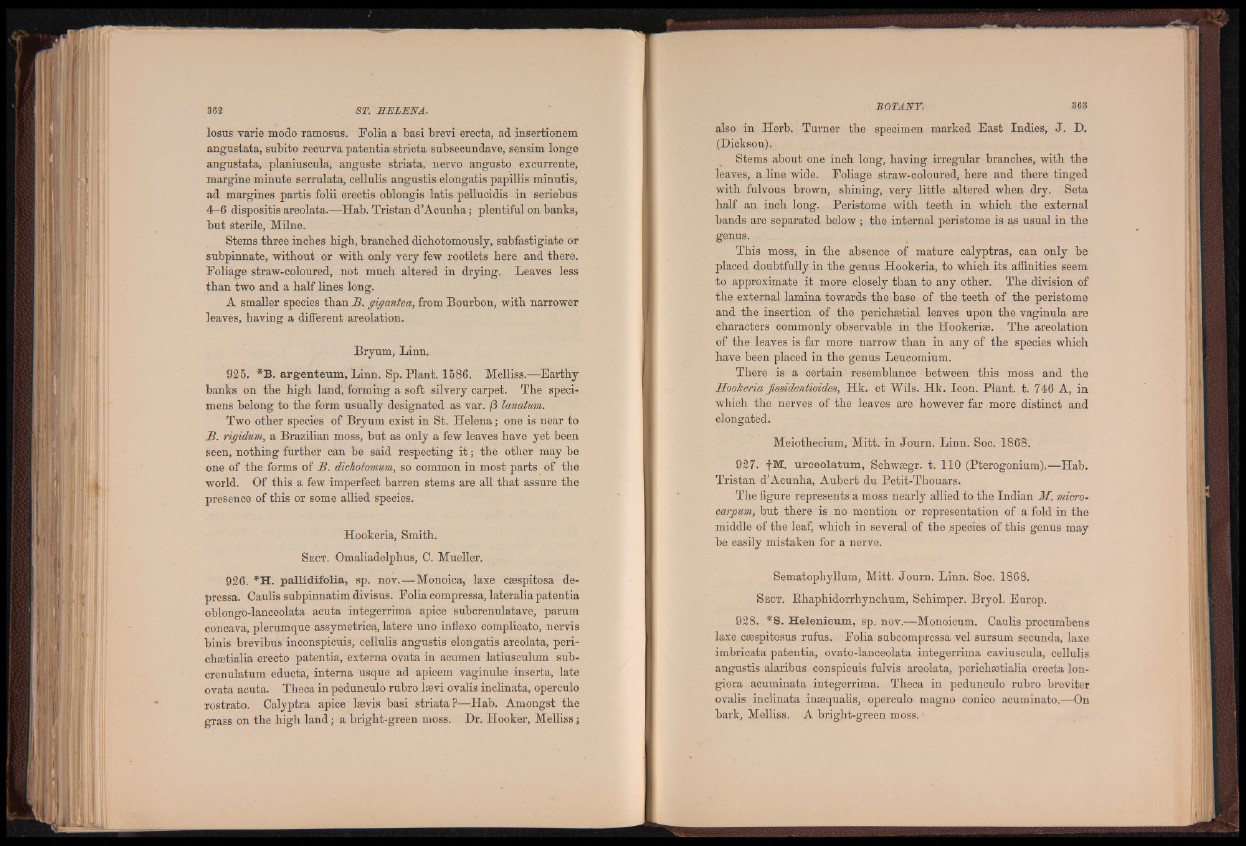
losus varie modo ramosus. Folia a basi brevi erecta, ad insertionem
angustata, subito recurva patentia stricta subsecundave, sensim longe
angustata, planiuscula, anguste striata, nervo angusto excurrente,
margine minute serrulata, cellulis angustis elongatis papillis minutis,
ad margines partis folii erectis oblongis latis pellucidis in seriebus
4-6 dispositis areolata.—Hab. Tristan d’Acunha; plentiful on banks,
but Sterile, Milne.
Stems tbree inches high, branched dichotomously, subfastigiate or
subpinnate, without or with only very few rootlets here and there.
Foliage straw-coloured, not much altered in drying. Leaves less
than two and a half lines long.
A smaller species than B. gig ant cm, from Bourbon, with narrower
leaves, having a different areolation.
Bryum, Linn.
925. *B. argenteum, Linn. Sp. Plant. 1586. Melliss.—Earthy
banks on the high land, forming a soft silvery carpet. The specimens
belong to the form usually designated as var. j3 lanatum.
Two other species of Bryum exist in St. Helena; one is near to
B. rigidum, a Brazilian moss, but as only a few leaves have yet been
seen, nothing further can be said respecting i t ; the other may be
one of the forms of B. dichotomum, so common in most parts of the
world. Of this a few imperfect barren stems are all that assure the
presence of this or some allied species.
Hookeria, Smith.
S ect. Omaliadelphus, C. Mueller.
926. *H. pallidifolia, sp. nov.—Monoica, laxe csespitosa de-
pressa. Caulis subpinnatim divisus. Folia compressa, lateralia patentia
oblongo-lanceolata acuta integerrima apice subcrenulatave, parum
concava, plerumque assymetriea, latere uno inflexo complicato, nervis
binis brevibus inconspicuis, cellulis angustis elongatis areolata, peri-
chaetialia erecto patentia, externa ovata in acumen latiusculum sub-
crenulatum educta, interna usque ad apicem vaginulse inserta, late
ovata acuta. Theca in pedunculo rubro lsevi ovalis inclinata, operculo
rostrato. Calyptra apice lsevis basi striata ?—Hab. Amongst the
grass on the high land; a bright-green moss. Dr. Hooker, Melliss;
also in Herb. Turner the specimen marked East Indies, J. D.
(Dickson).
Stems about one inch long, having irregular branches, with the
leaves, a line wide. Foliage straw-coloured, here and there tinged
with fulvous brown, shining, very little altered when dry. Seta
half an inch long. Peristome with teeth in which the external
bands are separated below; the internal peristome is as usual in the
genus.
This moss, in the absence of mature calyptras, can only be
placed doubtfully in the genus Hookeria, to which its affinities seem
to approximate it more closely than to any other. The division of
the external lamina towards the base of the teeth of the peristome
and the insertion of the perichastial leaves upon the vaginula are
characters commonly observable in the Hookeriae. The areolation
of the leaves is far more narrow than in any of the species which
have been placed in the genus Leucomium.
There is a certain resemblance between this moss and the
Hookeria Jissidentioides, Hk. et Wils. Hk. Icon. Plant, t. 746 A, in
which the nerves of the leaves are however far more distinct and
elongated.
Meiothecium, Mitt, in Journ. Linn. Soc. 1868.
927. fM. urceolatum, Schweegr. t. 110 (Pterogonium).—Hab.
Tristan d’Acunha, Aubert du Petit-Thouars.
The figure represents a moss nearly allied to the Indian M. micro-
carpum, but there is no mention or representation of a fold in the
middle of the leaf, which in several of the species of this genus may
be easily mistaken for a nerve.
Sematophyllum, Mitt. Journ. Linn. Soc. 1868.
S ect. Bhaphidorrhynchum, Schimper. Bryol. Europ.
928. *S. Helenicum, sp. nov.—Monoicum. Caulis procumbens
laxe csespitosus rufus. Folia subcompressa vel sursum secunda, laxe
imbricata patentia, ovato-lanceolata integerrima caviuscula, cellulis
angustis alaribus conspicuis fulvis areolata, perichastialia erecta lon-
giora acuminata integerrima. Theca in pedunculo rubro breviter
ovalis inclinata insequalis, operculo magno conico acuminato.—On
bark, Melliss. A bright-green moss. ■